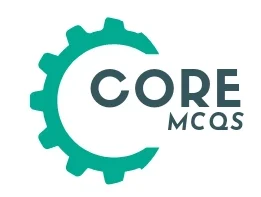11th class (FSc) Biology unit 11 MCQs
51. Glycolysis:
a. Takes place in the mitochondrion
b. Produce no ATP
c. Reduces two molecules of NAD for every glucose
d. Is the same as fermentation
52. The citric acid cycle:
a. Is the same thing as fermentation
b. Takes place in the mitochondrion
c. Has no connection with the respiratory chain
d. Reduces two molecules of NAD for every glucose
53. Which statement about the chemiosmotic mechanism is not true?
a. Proton pumping is associated with the respiratory chain
b. Protons return through the membrane by way of a channel protein
c. The membrane in question is the inner mitochondrial membrane
d. Protons are pumped a cross a membrane
54. Which statement about oxidative phosphorylation is not true?
a. It is brought about the chemiosmotic mechanism
b. Its functions can be served equally well by fermentation
c. It is the formation of ATP during operation of the respiratory chain
d. In eukaryotes, it takes place in mitochondria
55. Before pyruvate enters the citric acid cycle, it is decarboxylated, oxidized and combined with coenzyme A, forming acetyl CoA, carbon dioxide and one molecule of:
a. ATP
b. NADH
c. ADP
d. FADH2
56. In the first step of the citric acid cycle, acetyl CoA reacts with oxaloacetate to form:
a. NADH
b. Pyruvate
c. ATP
d. Citrate
57. When deprived of oxygen, yeast cells obtain energy by fermentation, producing carbon dioxide, ATP and:
a. Lactate
b. Acetyl CoA
c. Pyruvate
d. Ethyl alcohol
58. During the dark reactions of photosynthesis, the main process which occurs is:
a. Adding of hydrogen to carbon dioxide
b. Release of oxygen
c. Formation of ATP
d. Energy absorption by chlorophyll
59. The breakdown of terminal phosphate of ATP release3s energy about:
a. 7.5 k cals
b. 7.0 k cals
c. 8.1 k cals
d. 7.3 k cals
60. The process of Glycolysis occurs in:
a. E.R
b. Mitochondria
c. Cytosol
d. Ribosomes
61. Kreb’s cycle takes place in:
a. Cytosol
b. Cytoplasm
c. Nucleoplasm
d. Mitochondria
62. In respiratory chain, NADH is oxidized by:
a. Cytochrome a
b. Coenzyme Q
c. Cytochrome a3
d. Cytochrome b
63. The end product of glucose breakdown during glycolysis is:
a. Oxalic acid
b. Acetic acid
c. Pyruvic acid
d. Citric acid
64. Oxidative phosphorylation takes in conjunction with the respiratory chain in the inner membrane of:
a. Golgi body
b. Mitochondrion
c. Lysosome
d. Chloroplast
65. Conversion of one pyruvic acid into one acetyl COA gives off one molecule of:
a. NADH
b. Citrate
c. ATP
d. Pyruvate
66. Which one is the not phase of calvin cycle:
a. Regeneration of CO2 acceptor
b. Carbon fexation
c. Photophyrylation
d. Reduction
67. Glycolysis occurs in:
a. Chloroplast
b. Mitochondria
c. Cytosol
d. Ribosomes
68. End products of anaerobic respiration in yeast:
a. Ethyl alcohol only
b. Lactic acid
c. Alcohol and CO2
d. Methyl alcohol
69. The most abundant protein in chloroplasts and probably most abundant protein on earth is:
a. Insulin
b. Hemoglobin
c. Myosin
d. Rubisco
70. A great deal of energy is released during:
a. Photosynthesis
b. Respiration
c. Excretion
d. Reproduction
71. Plastocyanin protein contain:
a. Magnesium
b. Iron
c. Potassium
d. Copper
72. Which one is the copper containing protein:
a. Plastoquinone
b. Ferredoxin
c. Cytochromes
d. Plastocyanin
73. Which one is not the of calvin cycle:
a. Regeneration of CO2 acceptor
b. Carbon fixation
c. Phosphorylation
d. Reduction
74. The amount of energy present within the chemical bonds of glucose is converted into ATP during anaerobic respiration is:
a. 3%
b. 1%
c. 4%
d. 2%
75. Pyruvic acid is produced as a result of:
a. Phosphorylation
b. Krebs cycle
c. Respiratory chain
d. Glycolysis
